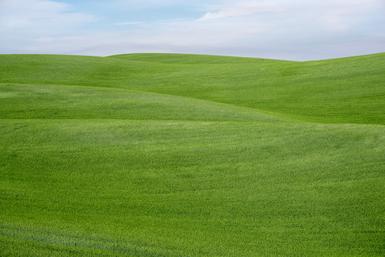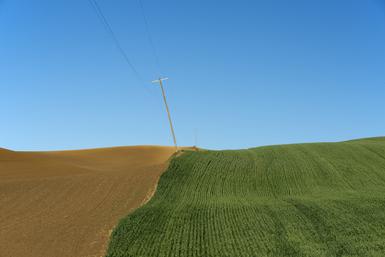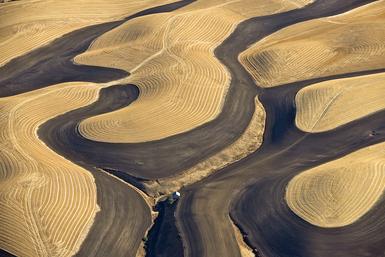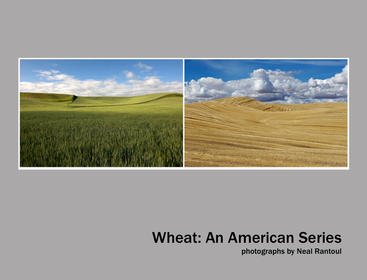Wheat 2016 Finish
This is the third and last installment of blogs about a trip I took to photograph wheat fields in SE Washington in October/November 2016.
In the last post about the aerial pictures I made I wrote that we were in the air for about an hour. As important as that one hour was for me and other aerial photographic excursions have been over many years, I spend the other nine or so days while out here by driving, stopping, hauling some camera out of the rental car, often setting it on a tripod, making a few exposures, reversing the same process and driving off, looking for the next picture to make, hour after hour and day after day. Most of my time I am on dirt roads, access roads that are there for the farmers to get their equipment to the fields. These can be treacherous, muddy and slippery after it rains and so dusty in the late summer at harvest time everything you own is covered in a fine powder. I used to have nightmares about this when working in 8 x 10.

 To break this down to fundamentals, there are two basic kinds kinds of pictures you can make here, photographs with horizons and ones without. I make both in about equal amounts. In the 18 or so times I've been here to photograph I don't think I have ever felt as though I've run out of material to photograph, as each season brings a different landscape. Drive, shoot, drive, shoot, etc. This is a very limited way to make pictures and needs a very disciplined approach, I know. But I find it fulfilling and rewarding as the pictures I have made now over many years seem to speak to me at some core level.
To break this down to fundamentals, there are two basic kinds kinds of pictures you can make here, photographs with horizons and ones without. I make both in about equal amounts. In the 18 or so times I've been here to photograph I don't think I have ever felt as though I've run out of material to photograph, as each season brings a different landscape. Drive, shoot, drive, shoot, etc. This is a very limited way to make pictures and needs a very disciplined approach, I know. But I find it fulfilling and rewarding as the pictures I have made now over many years seem to speak to me at some core level.
 The principle is extreme simplicity with elegance. This is very controlled photography that must be carried out with a maximum of attention to detail. There also are some really awful photographs made here: cliche'd, over wrought, and super saturated. Many photo t rips and workshops are offered here. I don't know whatever happened to restraint, refinement and discrimination. Try a Google Images search for the Palouse to see what I mean. Like this:
The principle is extreme simplicity with elegance. This is very controlled photography that must be carried out with a maximum of attention to detail. There also are some really awful photographs made here: cliche'd, over wrought, and super saturated. Many photo t rips and workshops are offered here. I don't know whatever happened to restraint, refinement and discrimination. Try a Google Images search for the Palouse to see what I mean. Like this:

The prevailing thought seems to be that if the colors are good somewhat realistically rendered then they will be better with the color sliders cranked to maximum. Same with sharpness. Hate that. Free country, I know, and others may do as they wish but for me more is not necessarily better.

 The color palette is determined by the season and the kind of light, meaning mostly the time of day. Mid days are usually not so good, blue and bleached looking. However, cloudy days mean good pictures can be made all day. My general advice is: get up before dawn, work until mid to late morning, eat, take a break midday and then get back to work by about 3 until the daylight is gone.
The color palette is determined by the season and the kind of light, meaning mostly the time of day. Mid days are usually not so good, blue and bleached looking. However, cloudy days mean good pictures can be made all day. My general advice is: get up before dawn, work until mid to late morning, eat, take a break midday and then get back to work by about 3 until the daylight is gone.
Tech: Most of my photography out here is with long lenses. Even with a long lens I find I can hand hold at times. Currently, I use two telephoto zoom lenses with the Nikon D810 camera; the Nikon f2.8 70-200mm in second generation version and also the variable f stop Nikon 80-400mm f/4.5-5.6G ED VR lens. The 70-200mm is slightly better but can vignette at long length and the 80-400mm is amazing considering its reach. With both you need to be aware of the clarity of the air. Also at longer lengths a tripod isn't always a guarantee, especially in wind. It is often windy here. This written from personal experience.
As I write this today, I just got home last night. Don't ask me about flying on commercial airplanes as it is not good out there. That being said, my flights to and from Spokane, WA( the closest real city) were uneventful and on time. I do advise getting approved for the TSA Pre Check as it does speed things up in security.
In the next week or so, as I begin to work the files, I will post both ground-based and aerial wheat field pictures on the site.
Stay tuned.




